Guitar strings notes chart, tab and notation: everything you need to learn the notes of the guitar fretboard.
- Part of our Guitar Basics series.
Guitar Strings Notes: Your Complete Guide To The Guitar Fretboard
This page contains a complete guide to the guitar fretboard. Using the charts and diagrams on this page you'll be able to find out where to play any note.
Page Index: Use The Links Below To Jump Straight To The Section You Need!
- Guitar Tuning Chart (Find out what notes guitar strings are tuned to)
- Guitar String Numbers (What is the 1st string? Guitar string numbering convention)
- Guitar Strings Notes On Piano (Guitar notes in piano notation)
- Guitar Strings Notes Chart (Shows every note on the guitar fretboard)
- Individual Guitar Strings Notes (Shows every note on each string in musical notation and tab)
- How To Learn The Notes On A Guitar Fretboard (The best way of learning guitar notes)
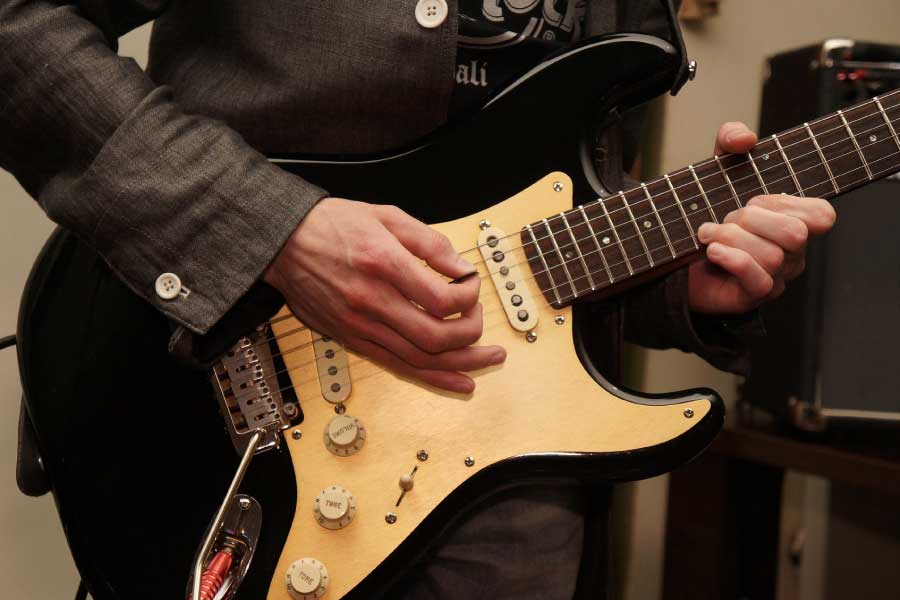
Guitar Strings Tuning Chart
The picture below shows the notes you should tune the strings of your guitar to. This is the standard way of tuning a 6 string guitar.
There are other ways of tuning a guitar. These include 'drop-D tuning', in which the bottom string is tuned down a whole tone to a D; and DADGAD, in which the strings are tuned D, A, D, G, A, D from bottom to top.
All of the charts and diagrams on this page represent a guitar tuned with standard tuning, as shown below.

Guitar String Numbering
Guitar strings are numbered from top E to bottom E as shown below:
- Top E (the highest / thinnest string): 1st string
- B: 2nd string
- G: 3rd string
- D: 4th string
- A: 5th string
- Bottom E (the lowest / widest string): 6th string
Guitar Notes On Piano
Guitar music is written an octave higher than it sounds:
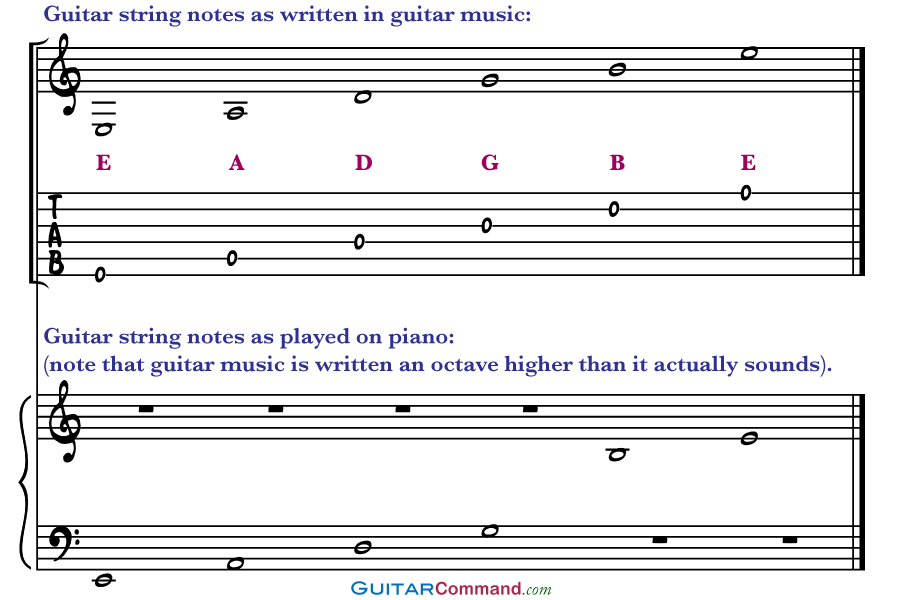
Guitar Strings Notes Chart
Below is a chart showing all of the notes on a guitar fretboard. You can use the chart to find out where notes are.
The notes repeat after the 12th fret (e.g. the notes at the 13th fret, from 6th string to 1st string are: F, A#/Bb, D#/Eb, G#/Ab, C, F).
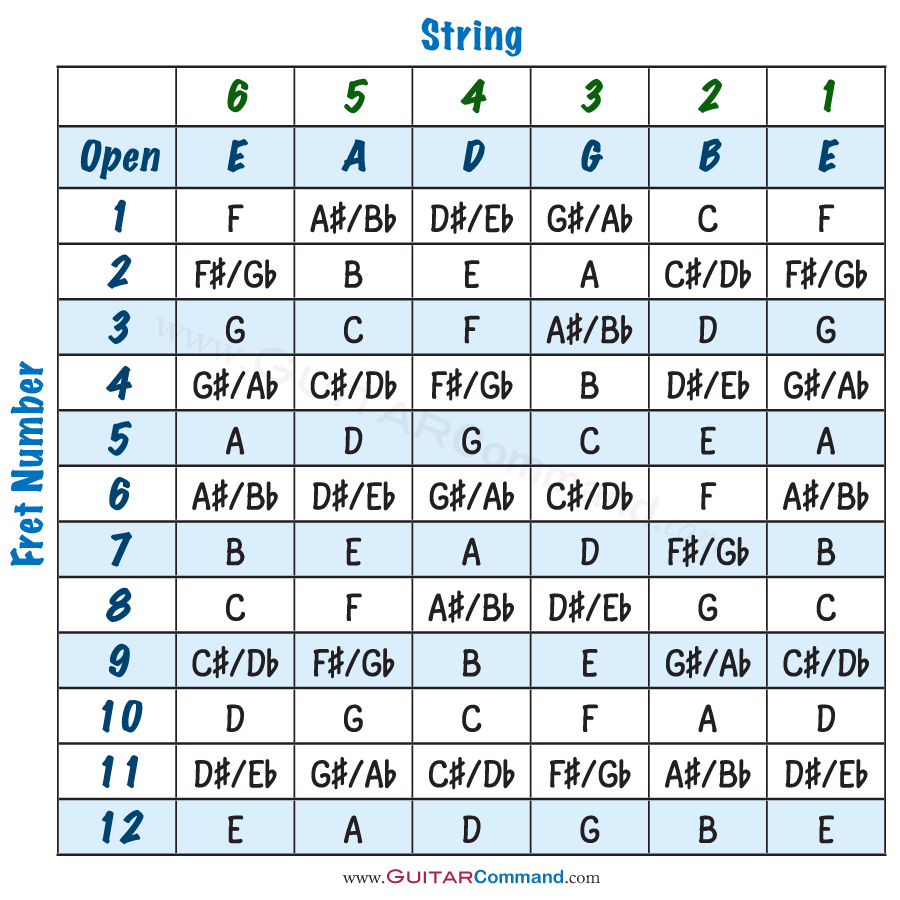
Individual Guitar Strings Notes: Tab & Music Notation
The following diagrams show every note on a guitar fretboard with its corresponding musical note in tab and notation. (Tab is a system of guitar notation. If you haven't come across tab before, see our page on how to read tab.)
Each diagram shows the notes of an individual string. After the twelfth fret the notes simply repeat along each string an octave higher.
After the diagrams is an explanation of what to do if the note you wish to play is either sharpened (i.e. has a little # sign next to it), or flattened (i.e. has a little 'b' sign next to it).
1st (Top E) String Notes

Guitar B String Notes
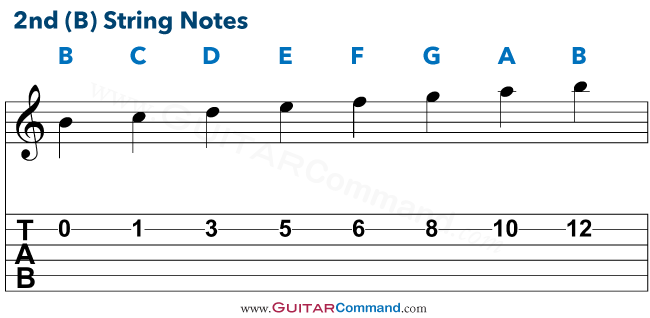
Guitar G String Notes

Guitar D String Notes
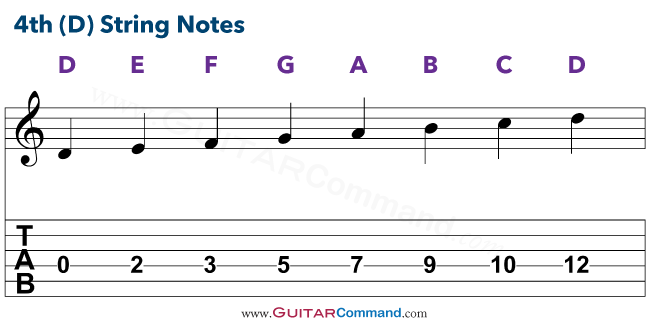
Guitar A String Notes
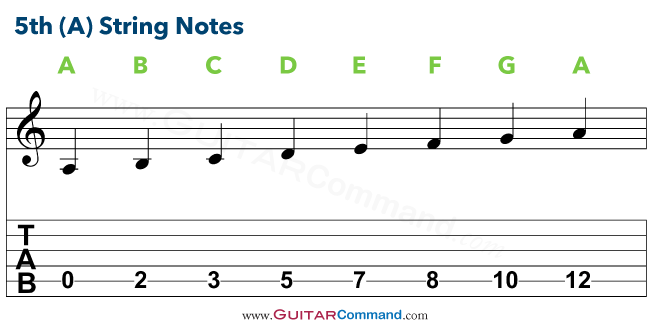
Guitar Bottom E String Notes Tab
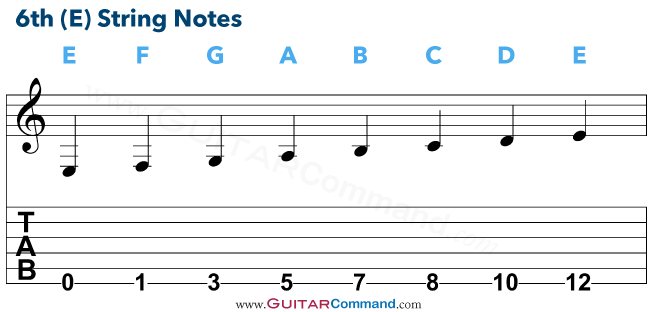
How To Play Sharp / Flat Notes
In music, notes are often 'sharpened' or 'flattened'. Sharpened notes have a sharp sign (which looks like a hash: #) next to them. Flattened notes have a flat sign (which looks like a small letter 'b') beside them.
Sharpened Notes
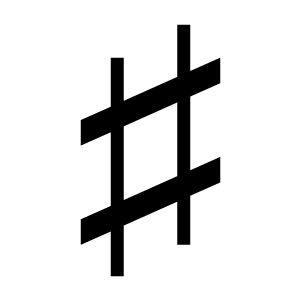
In music notation, notes can be 'sharpened'. A sharp symbol (see below) is placed next the the note. A sharp raises the pitch of a note by a semitone. Therefore, if you see a sharp sign next to a note, you should play it one fret higher.
Note: Sharpened and flattened notes can lead to 'enharmonic' notes (e.g. A# and Bb) which are the same pitch, but with different names.
Flattened Notes

In notation, notes can also be 'flattened'. A flat symbol lowers the pitch note by a semitone (one fret). Therefore, if you see a flat sign next to a note, you should play it one fret lower.
One Thing To Remember ...
The same note can often be played in more than one place on a guitar fretboard.
For example, the A played at the 5th fret of the 6th (bottom E) string is the same note as the open 5th (A) string.
The E note of the open 1st (top E) string is found in 4 other places on some electric guitars – and 5 other places on 24 fret guitars! Can you find them all? (Without looking at the guitar notes diagram!)
The Best Way To Learn Guitar Strings Notes
The best way to learn guitar string notes is by playing guitar scales. Play various scales at random positions on the guitar neck. (You can find suitable scales here: Guitar Scales.) As you play the scales, say the name of the individual notes aloud.
If you do this for a few minutes every day you'll soon learn all of the notes on the fretboard.
Do I Need To Learn All Of The Notes On Every Guitar String?
Learning guitar strings notes doesn't have to be hard work. It doesn't even take long, provided you set your mind to it.
Not every guitarist learns all of the notes on a guitar fretboard. There are plenty of players who get by with just a basic knowledge of the notes on the bottom E and A strings (useful for knowing where to play barre chords) and not a lot else.
That's fine, but we think that a good knowledge of the fretboard is helpful: not only with your guitar playing, but also with your enjoyment and understanding of music.
By learning what notes you're playing, you'll begin to see how chords and scales are constructed and improve your understanding of how music works.
Guitar Strings Notes Conclusion
We hope that you have found this page useful. Other pages on Guitar Command you may enjoy include:
- Guitar Basics (Learn the basics of guitar playing, including playing techniques and guitar types).
- Guitar Scales (Contains a large amount of guitar scales that you can use in improvisation and songwriting).
- Guitar Backing Tracks (Download backing tracks to practice your lead guitar solos).

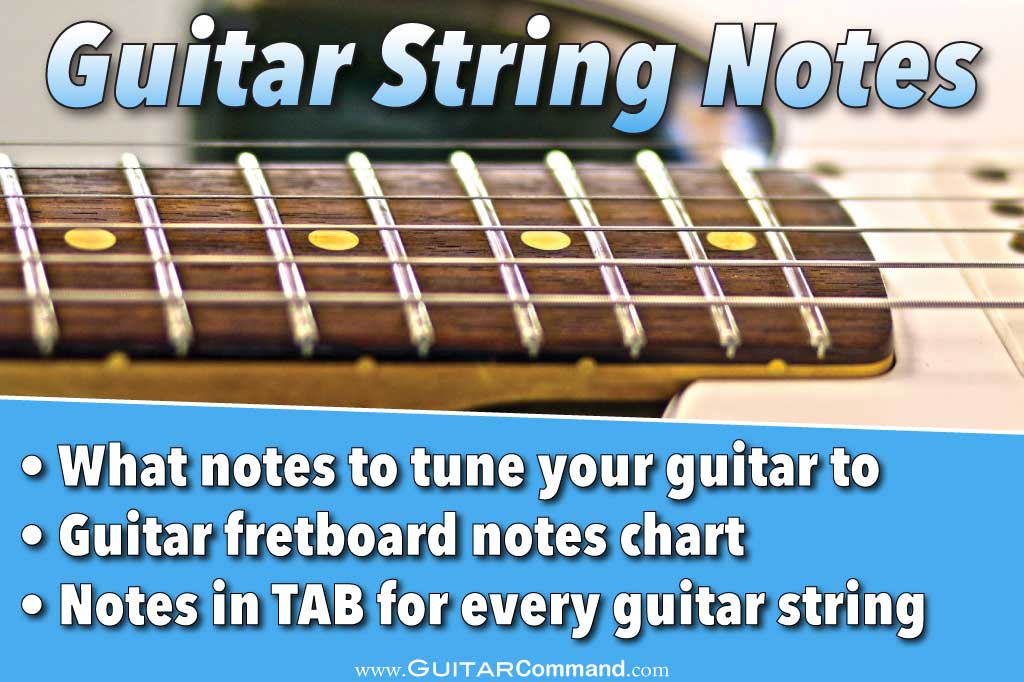

Thank you for your note information. I was stalled reading a music book.
Great place for poor old boys who can’t afford lessons, true guitarist
Glad you found it useful, thanks for stopping by!
This is what I have been trying to get. Has every thing I need.
Thank you
You’re welcome!
thank you so much for your great explanation. you guys really saved me.
No worries shaghayegh, thanks for stopping by! 🙂
So helpful! Just retired an now applying myself seriously to what I started in college! lol
Lol! Enjoy your playing 🙂
Great Website Greetings From Sri Lanka
Thanks so much! It’s great to hear from guitarists from all over the world 🙂
Good luck with your playing!
Guitar Command Admin
This is perfect! Thank you so much for these Useful Charts
You’re welcome! Thanks for dropping by! 🙂
Whoa….I actually am learning by myself with this chart, I know basic chords, but with this I can build them on a guitar, not just a piano.
That’s great to hear! Thank you for your comment 🙂
I thank you for your simple way to present the material
You’re welcome Aldana! Good luck with your playing 🙂
AMAZING AND HELPFUL! Love your charts. God bless you, really helped me. Youre very kind.
Outstanding chart. Very helpful references. I’m printing the partitions I have trouble with. Thank you!
Hi Rene,
No problem! I’m glad you found the chart useful.
Thanks for this information. I find it very useful after not playing the guitar for at least 2 decades!
Hi Sharmi,
Thanks for stopping by! Welcome back to the guitar world!